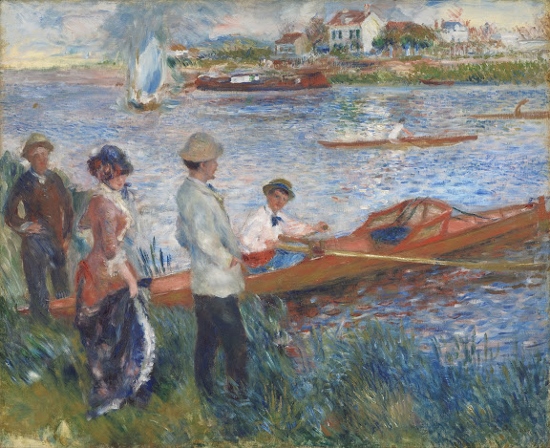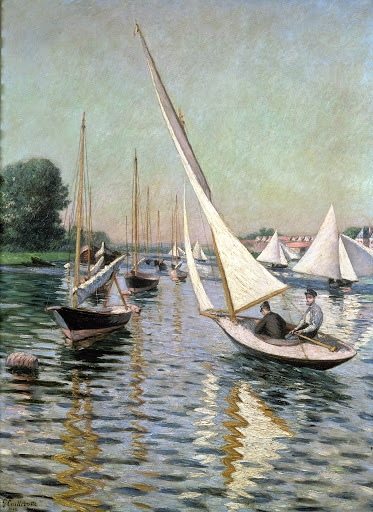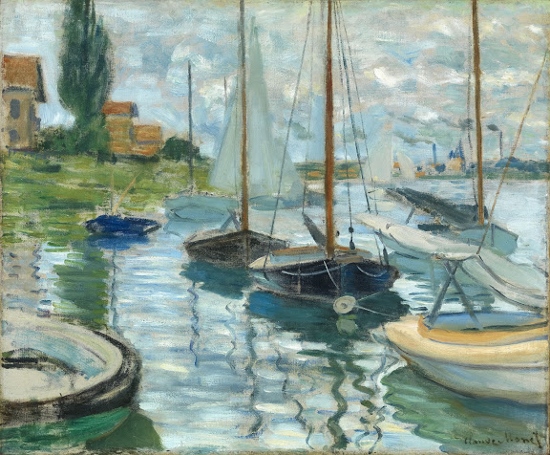In celebration of the summertime America's Cup race opening this week in San Francisco, the California Palace of the Legion of Honor presents "Impressionists on the Water" (through October 13, 2013). The show explores the Impressionists' fascination with sailing, a popular pastime and competitive sport in late 19th century France. It's a fitting theme for this Beaux-Arts museum set high on a bluff overlooking the sparkling San Francisco Bay and Golden Gate Bridge.
Boating proved an irresistible motif for the Impressionists, many of whom were sailors and yachtsman themselves. Camille Pissarro sailed the Atlantic, Frederic Bazille was a champion rower, and Claude Monet painted many of his famous views of the Seine from a floating boat. At the same time they were capturing the ephemeral quality of the water, the artists were demonstrating a practical familiarity with hulls, sails and rigging.
"I hope visitors leave the exhibition with a new understanding of how skilled these artists were -- as painters, sailors and in some cases, boat designers," says Melissa Buron, Assistant Curator of European Art at the Fine Arts Museums of San Francisco. "The synergy between advances in boat designs of the 19th century and the technology used to design the world's fastest boats for the America's Cup races is another important connection that is unique to our presentation."
Taking their easels outdoors, the Impressionists used boats to explore the effects of wind and light on the water. Through some 85 paintings and works on paper, "Impressionists on the Water" follows the changing depictions of nautical themes from pre-Impressionism (Corot and Daubigny) through Impressionism (Monet, Pissarro, Renoir and Caillebotte) and neo- and post-Impressionism (Cézanne, Seurat and Signac). 
Pierre-Auguste Renoir Oarsmen at Chatou 1879 National Gallery of Art, Washington, D.C.
To underscore the artistic and social significance of boats, the show's curators have installed half a dozen boat models and two vintage boats in the galleries. Among these are Nana, a two-person pleasure rowboat or gig reputedly owned by Emile Zola, the kind of boat Renoir painted in the foreground of Oarsmen at Chatou along with a full-size skiff of the type featured in Skiffs on the Yerre by Gustave Caillebotte. 
Gustave Caillebotte Regatta at Argenteuil, 1893. Private collection. Photograph © Comité Caillebotte, Paris
It's the lesser-known Caillebotte who's the star of this exhibition thanks to his talent as a boat designer and builder. In Regatta at Argenteuil, the artist places himself at the helm of his finest boat, Roast Beef. A large photo mural of the Roast Beef on the water along with Caillebotte's model for a sister ship are found at the end of the exhibition. Through his passions for art and boating, Caillebotte forged friendships with Claude Monet and Auguste Renoir, who sailed with him on the Seine and invited him to join the Impressionists. Caillebotte was also an enthusiastic collector of his friends' paintings, many of which hang today at the Musée d'Orsay in Paris.
Inspired by Charles-Francois Daubigny's boat, Monet had a similar vessel constructed which he used as a floating studio. Monet took trips on the boat, including a family voyage down the Seine to Rouen, whose cathedral he immortalized in one of his famous series. Moored near his home in Argenteuil, the boat gave Monet a unique perspective of the Seine's waterways and shoreline -- a way as he put it to observe "the effects of light from one twilight to the next." Monet painted his boat three times, studying the effects of shadow and reflection. The first of these canvases, "The Studio Boat" is included in the show, along with "The Seashore at Sainte-Adresse" and "Boats Moored at Le Petit-Gennevilliers".
Claude Monet Boats Moored at Le Petit-Gennevilliers 1874, Fine Arts Museums of San Francisco Photograph ©FAMSF
Monet and Renoir often painted similar scenes and in 1874 they painted the same regatta -- producing "Regatta of Argenteuil" and "Seine at Argenteuil" respectively. Their colleague Alfred Sisley took a very different approach in "Banks of the Loing" in which a lone boat rests on a beach while the sunlight shimmers on a row of trees along the bank of a green river. Sisley settled near Fontainebleau in Moret-sur-Loing in 1882, attracted by the picturesque small town and its riverbank location.
Another avid boater, Paul Signac, sailed the coasts of Europe in some 30 boats he owned during his lifetime. Beginning in 1892, Signac sailed to almost all the ports of France, as well as the Mediterranean and Holland bringing back vibrant, colorful watercolors. From these sketches, he produced large canvases in small, mosaic-like squares of color, thicker than the tiny dots used by his Pointillist colleague, Georges Seurat.
After its San Francisco run, "Impressionists on the Water" travels to the Peabody Essex Museum in Salem, Massachusetts, opening November 9, 2013. The exhibition features works from the Fine Arts Museums of San Francisco along with loans from private collections and the Musée d'Orsay, National Gallery of Art, Stockholm's Nationalmuseum, Stockholm; and the Kröller-Müller Museum in the Netherlands. For more information, click here.
Susan Jaques is the author of "A Love for the Beautiful: Discovering America's Hidden Art Museums" (Globe Pequot Press, November 2012). http://www.susanjaques.com/
